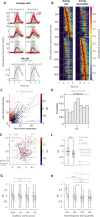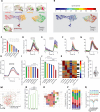Movement-Related Modulation in Mouse Auditory Cortex Is Widespread Yet Locally Diverse
- PMID: 38286628
- PMCID: PMC10941236
- DOI: 10.1523/JNEUROSCI.1227-23.2024
Movement-Related Modulation in Mouse Auditory Cortex Is Widespread Yet Locally Diverse
Abstract
Neurons in the mouse auditory cortex are strongly influenced by behavior, including both suppression and enhancement of sound-evoked responses during movement. The mouse auditory cortex comprises multiple fields with different roles in sound processing and distinct connectivity to movement-related centers of the brain. Here, we asked whether movement-related modulation in male mice might differ across auditory cortical fields, thereby contributing to the heterogeneity of movement-related modulation at the single-cell level. We used wide-field calcium imaging to identify distinct cortical fields and cellular-resolution two-photon calcium imaging to visualize the activity of layer 2/3 excitatory neurons within each field. We measured each neuron's responses to three sound categories (pure tones, chirps, and amplitude-modulated white noise) as mice rested and ran on a non-motorized treadmill. We found that individual neurons in each cortical field typically respond to just one sound category. Some neurons are only active during rest and others during locomotion, and those that are responsive across conditions retain their sound-category tuning. The effects of locomotion on sound-evoked responses vary at the single-cell level, with both suppression and enhancement of neural responses, and the net modulatory effect of locomotion is largely conserved across cortical fields. Movement-related modulation in auditory cortex also reflects more complex behavioral patterns, including instantaneous running speed and nonlocomotor movements such as grooming and postural adjustments, with similar patterns seen across all auditory cortical fields. Our findings underscore the complexity of movement-related modulation throughout the mouse auditory cortex and indicate that movement-related modulation is a widespread phenomenon.
Keywords: auditory; behavior; imaging; modulation; movement; state.
Copyright © 2024 the authors.
Conflict of interest statement
The authors declare no competing financial interests.
Figures





Update of
-
Movement-related modulation in mouse auditory cortex is widespread yet locally diverse.bioRxiv [Preprint]. 2023 Jul 3:2023.07.03.547560. doi: 10.1101/2023.07.03.547560. bioRxiv. 2023. Update in: J Neurosci. 2024 Mar 13;44(11):e1227232024. doi: 10.1523/JNEUROSCI.1227-23.2024. PMID: 37461568 Free PMC article. Updated. Preprint.
References
-
- Bagur S, et al. (2022) A spatial code for temporal cues is necessary for sensory learning. bioRxiv 12.14.520391.
Publication types
MeSH terms
Substances
Grants and funding
LinkOut - more resources
Full Text Sources
Molecular Biology Databases
Miscellaneous
